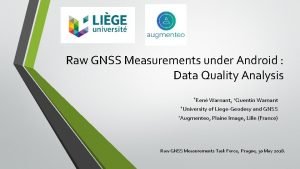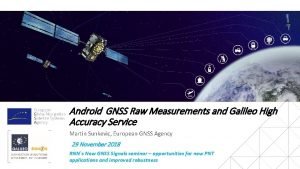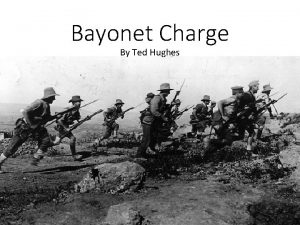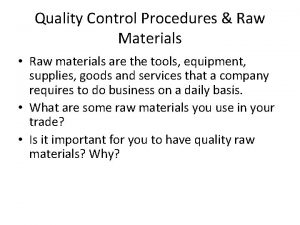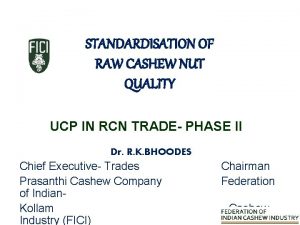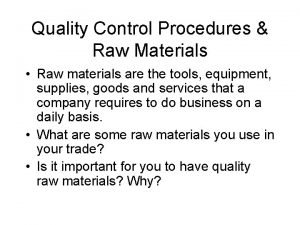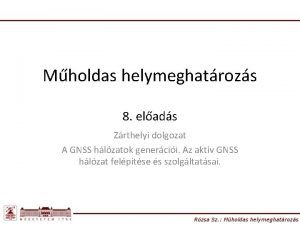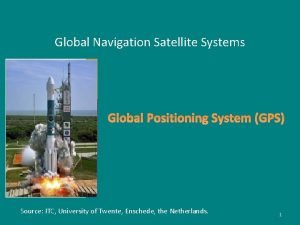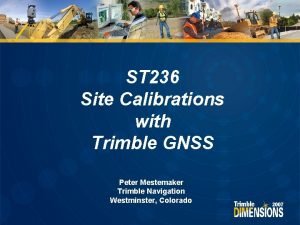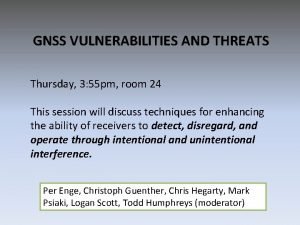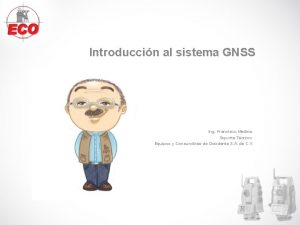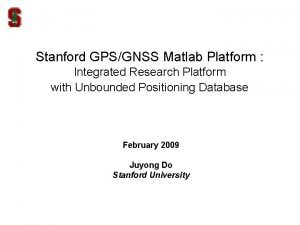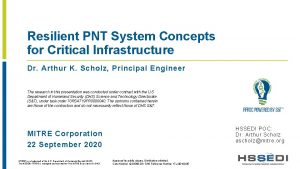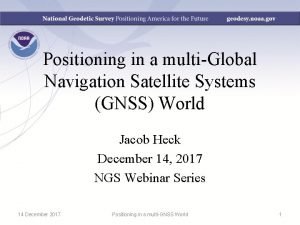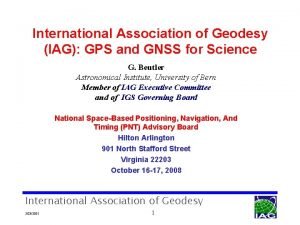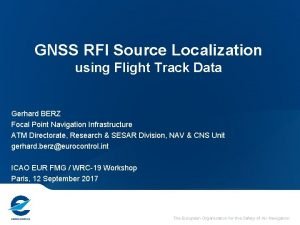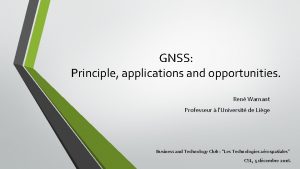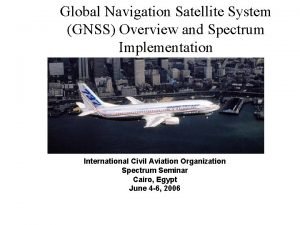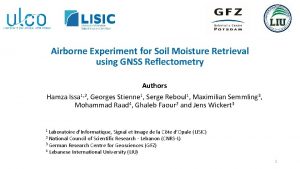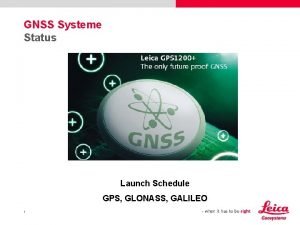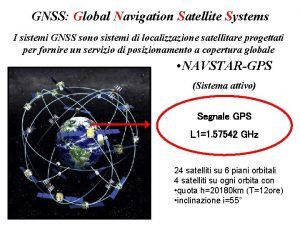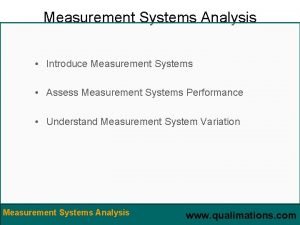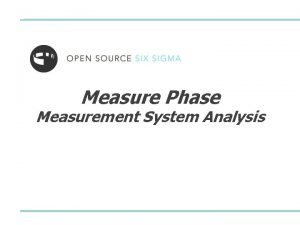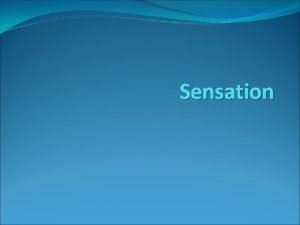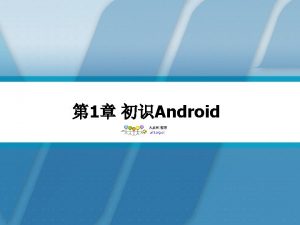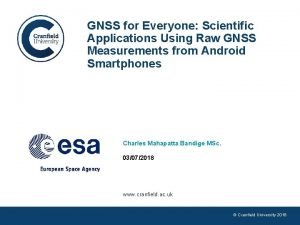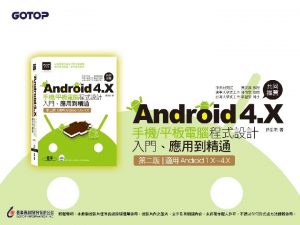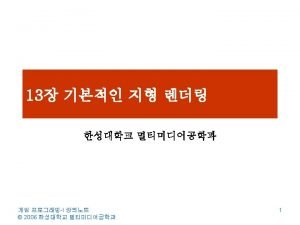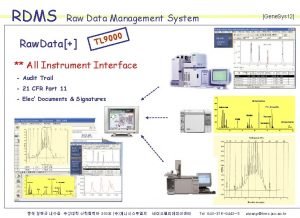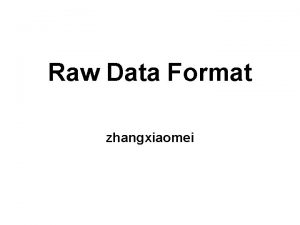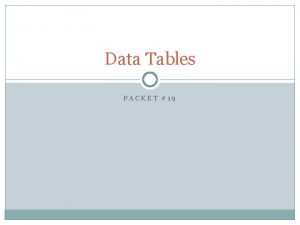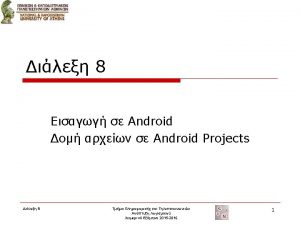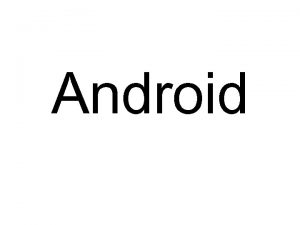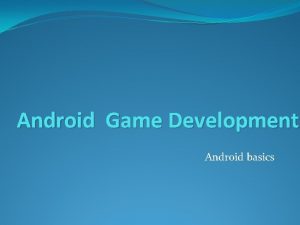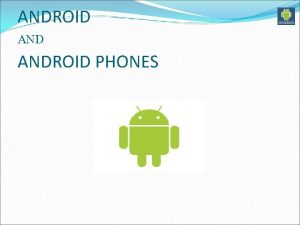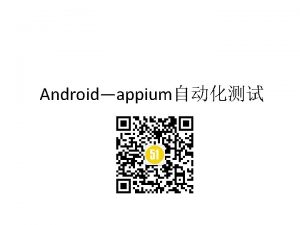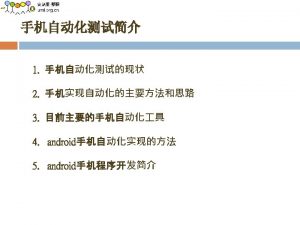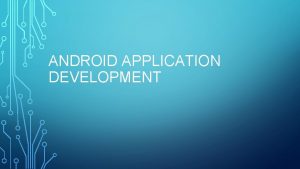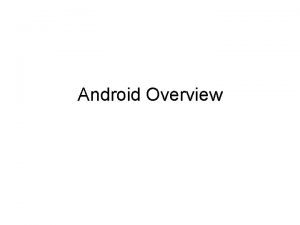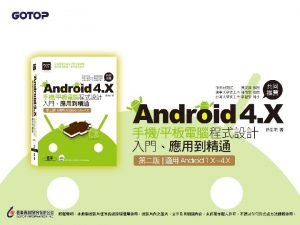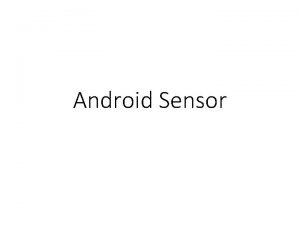Raw GNSS Measurements under Android Data Quality Analysis























- Slides: 23

Raw GNSS Measurements under Android : Data Quality Analysis *René Warnant, +Quentin Warnant *University of Liege-Geodesy and GNSS +Augmenteo, Plaine Image, Lille (France) Raw GNSS Measurements Task Force, Prague, 30 May 2018.

Background • Laboratory Geodesy and GNSS of the University of Liege is mainly involved in the Geodetic Community. • Research on: • multi-GNSS/multi-frequency precise positioning mainly with geodetic receivers but also with low-cost devices (UBLOX). • GNSS-based ionosphere monitoring • Assessing the potential of (dual frequency) smartphones for these 2 research topics. 2

GNSS equipment: Geodetic receivers • Located in Liege (Belgium) – open sky. • 2 Trimble GNSS choke ring antennas on a short baseline (5, 352 m). • 6 multi-GNSS/multi-frequency receivers : • • 2 Trimble Net. R 9 receivers 2 Septentrio Pola. Rx 4 receivers 1 Septentrio Pola. Rx. S scintillation receiver 1 Septentrio Pola. Rx 5 (new model). • 1 Multi-GNSS/multi-frequency field receiver: • 1 Trimble R 10

GNSS equipment: Smartphones • 4 smartphones running Android 7 (2017) and Android 8 (2018): • • Huawei Mate 9 and P 10 Samsung Galaxy S 8 and S 8+ • Multi-constellation: • GPS, GLONASS, Galileo, Beidou, QZSS (available but not processed so far) • Raw Data acquisition using GNSSLogger (Google). 4

The data set • Data collected in different situations (static, pedestrian, car) and environments (open sky, trees and buildings, highways, …) in Belgium, Spain and Japan ~ 350 data files. • We are using our own software fully dedicated to Smartphone data processing (still under development !). • At the moment we focus on the “best achievable” results with smartphones. • In this talk, results are mainly (but not only) based on five 10 minute-sessions on the roof of our building in Liege (open sky) close to the geodetic receivers. • More complete statistics will be presented at ION GNSS. 5

Data quality and positioning • It is important to assess data quality as: • In addition, Smartphone Raw GNSS measurements have “particular” characteristics meaning that the “usual” data processing strategies might not be optimal. 6

Phase measurements and duty cycle • At the present time, only the HTC Nexus 9 is not affected by the duty cycle. • Nevertheless, using our 4 smartphones, we have been able to regularly collect periods of 3 to 4 minutes of continuous phase measurements after a “cold” start. • Sometimes, longer periods are available: up to 50 minutes of (nearly) continuous phase pseudoranges ! 7

Tracking of Galileo satellites • All smartphones used in our study are Galileo compatible, nevertheless, Galileo tracking is not always “straightforward”. • Usually, the tested smartphones are NOT able to track all Galileo satellites in view (not considering unhealthy satellites). • Under Android 7, it was very difficult to track simultaneously 4 Galileo satellites mainly with Huawei Mate 9 and P 10. • Partly du to lack of Galileo-aided data ? • Under Android 8, the situation has improved: • TOW can be injected from an external source. • Nevertheless, even if Galileo satellites are tracked, most Code pseudorange remain ambiguous. 8

Code “Ambiguity” (1/2) • Receivers need to synchronize with satellite signals. • This is done in several steps. • When the receiver code is locked to the satellite code, the code pseudorange measurement is still ambiguous • For example, 1 ms ambiguous for GPS C/A Code. • It remains ambiguous until the TOW is decoded (using the navigation message). 9

Code “Ambiguity” (2/2) • For GPS, GLONASS and Beidou, “the ambiguity resolution” is usually performed in a short time. • It is NOT the case for Galileo : most collected measurements are ambiguous on the tested devices ! • The ambiguity can be (rather) easily solved: • • • Get approximate values of the receiver position and clock error. Compute a modelled code pseudorange Solve the ambiguity if the accuracy of the modelled pseudorange is better than the ambiguity 10

Proportion of ambiguous code pseudoranges • Proportion of ambiguous code pseudoranges wrt all available data (Samsung Galaxy S 8) during five 10 -minute sessions. • In our software, code ambiguity resolution is activated ONLY for Galileo. • Pseudoranges flagged “Millisecond ambiguous” are NOT corrected (so far). Samsung Galaxy S 8 GPS Galileo Beidou Unambiguous data Available data after code AR (%) 82 6 60 69 11

Clock behaviour • • On all available data (~350 files), only a few clock jumps (requires further analysis). Usually very regular linear drift: • • • ~300 -400 ns/s for Huawei Mate 9, P 10 and Samsung Galaxy S 8. ~3 -8 ns/s for Samsung Galaxy S 8+ (not always linear). Clock error can be larger than 1 ms during longer sessions. 12

Combinations used to assess data quality • Three different combinations to assess data quality: • • • Code Minus Phase Code Range Rate Minus Phase Range Rate (less “sensitive” to multipath). Code Double Differences on a short baseline (smartphones close to each other). • The consistency of the results has been controlled by comparing the 3 combinations • The comparison also helps to separate noise and multipath. 13

Precision, CNo and elevation (1/3) • When using Geodetic receivers, CNo and GNSS measurement precision increase with satellite elevation. • In data processing techniques, this characteristic is often exploited in the variance-covariance matrix. • Raw GNSS Smartphone data do not behave in the same way meaning that data processing strategies must be modified accordingly. 14

Precision, CNo and elevation (2/3) Precision: 8, 0 m Mean CNo: 22, 8 Mean elevation: 73, 3° 15

Precision, CNo and elevation (3/3) Operator touching the phone Precision: 2, 0 m Mean CNo: 42, 5 Mean elevation: 11, 9° 16

Code pseudorange precision depending on CNo • Samsung Galaxy S 8: Code precision as a function of mean satellite CNo computed based on five 10 -minute sessions using Code Range Rate Minus Phase Range Rate Galaxy S 8 CNo ≥ 37, 5 30 ≤ CNo < 37, 5 22, 5 ≤ CNo < 30 15 ≤ CNo < 22, 5 GPS 2, 550 4, 272 6, 302 8, 439 3, 729 GLONASS 4, 876 7, 386 12, 368 13, 337 7, 694 Galileo 2, 188 2, 855 2, 993 - 2, 638 Beidou 0, 912 2, 063 2, 967 - 2, 208 ! More data necessary ! Mean 17

Code pseudorange precision depending on CNo • Huawei Mate 9: Code precision as a function of satellite mean CNo (same conditions). Huawei Mate 9 CNo ≥ 37, 5 30 ≤ CNo < 37, 5 22, 5 ≤ CNo < 30 15 ≤ CNo < 22, 5 Mean GPS 2, 372 5, 176 7, 429 - 4, 089 GLONASS 4, 598 7, 503 12, 319 - 5, 231 Galileo 2, 080 2, 584 3, 449 - 2, 439 Beidou - 2, 039 3, 002 - 2, 499 ! More data necessary ! 18

Multipath • An example of strong multipath (Complete statistics not yet available). 19

Conclusions • The tested Smartphones clocks have a regular drift and only few jumps have been experienced (short sessions). • Most Galileo Code pseudoranges are ambiguous but the ambiguity can be easily solved. • CNo and Code pseudorange precision have no clear relationship with satellite elevation. • Huawei Mate 9 and Samsung Galaxy S 8 have the same level of accuracy. • Mean Code Pseudorange precision is better for Beidou and Galileo than for GPS and GLONASS. 20

Code Minus Phase • Neglecting: • • Hardware biases variability (short periods) Phase multipath and noise wrt code multipath and noise • The Code-Phase combination depends on: • • • Two times the ionosphere error Code multipath and noise Phase ambiguity and possible cycle slips. • When removing the mean value of the combination (period of about 240 s): • • • Ionosphere variability (usually negligible on a short period) Code multipath (variability) and noise Cycle slips 21

Code Range Rate Minus Phase Range Rate • Under the same assumptions, the Code Range Rate Minus Phase Range Rate combination depends on (1 sec sampling rate): • • Ionosphere rate of change (negligible) Code multipath rate of change Noise Cycle slips ( outliers) 22

Double difference of Code • On a short baseline (smartphones close to each other): • • • Code multipath (combination of multipath on 4 code pseudoranges) • Residual term due to the fact that the measurement are not collected exactly at the same (GPS) time. Noise Residual geometry (coordinates of the 2 smartphone antennae not precisely known) but negligible wrt code noise. 23
 Force full gnss measurements android
Force full gnss measurements android Pnt
Pnt Raw seamed hot khaki
Raw seamed hot khaki Receiving raw materials
Receiving raw materials Spotted cashews
Spotted cashews Quality control of raw materials
Quality control of raw materials Gnss igazolás
Gnss igazolás Three segments that make up a gnss
Three segments that make up a gnss Gnss site calibration
Gnss site calibration Gnss vulnerabilities
Gnss vulnerabilities Sistemas de aumentacion gnss
Sistemas de aumentacion gnss Stanford gps
Stanford gps Resilient pnt
Resilient pnt Gnssplanningonline
Gnssplanningonline Pnt gnss
Pnt gnss Pnt gnss
Pnt gnss Gnss
Gnss Gnss receiver
Gnss receiver Gnss
Gnss Galileo satelliten status
Galileo satelliten status Differenza tra gnss e gps
Differenza tra gnss e gps Measurements system analysis
Measurements system analysis Attribute repeatability and reproducibility
Attribute repeatability and reproducibility Raw data of experience
Raw data of experience
